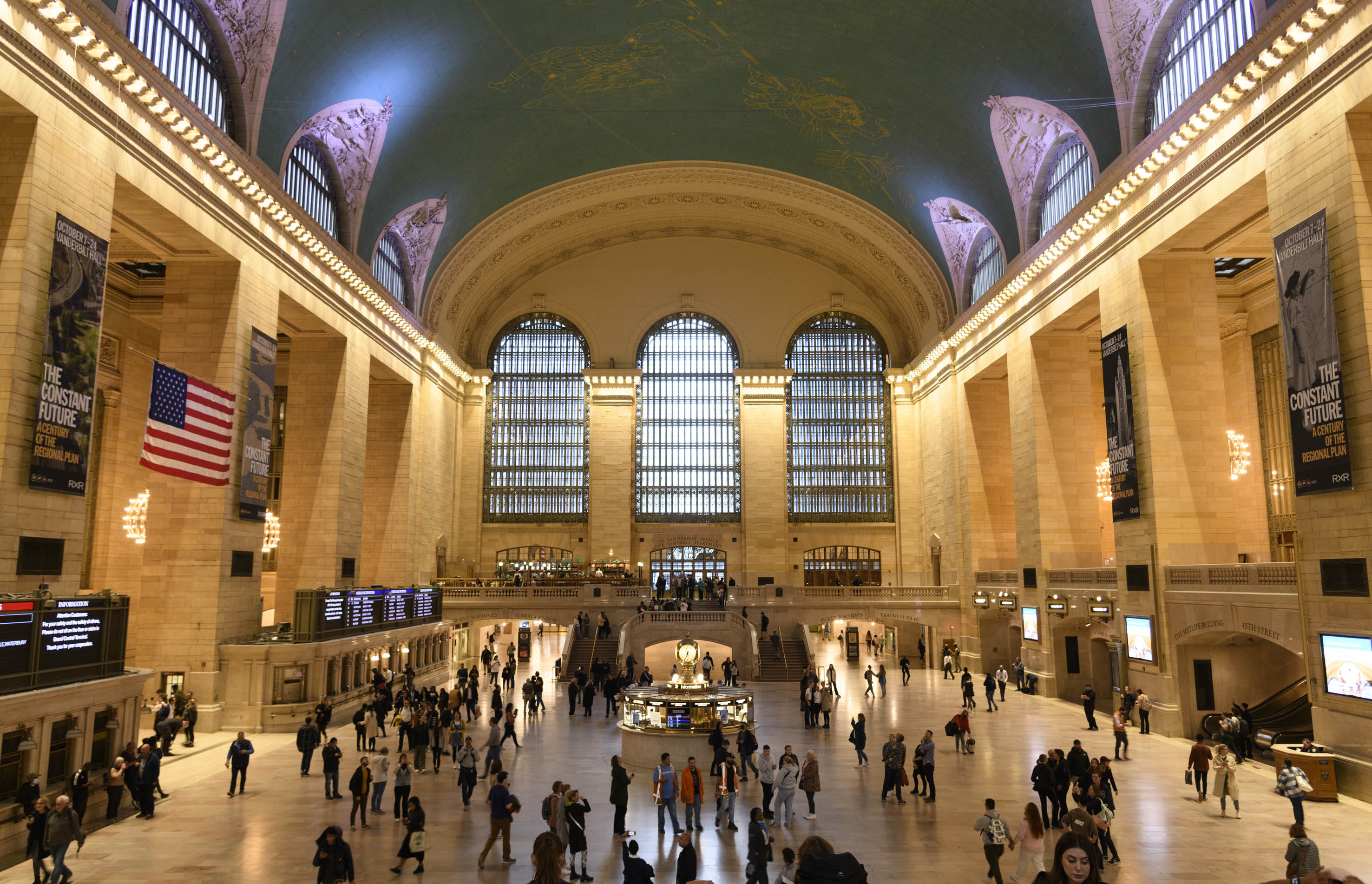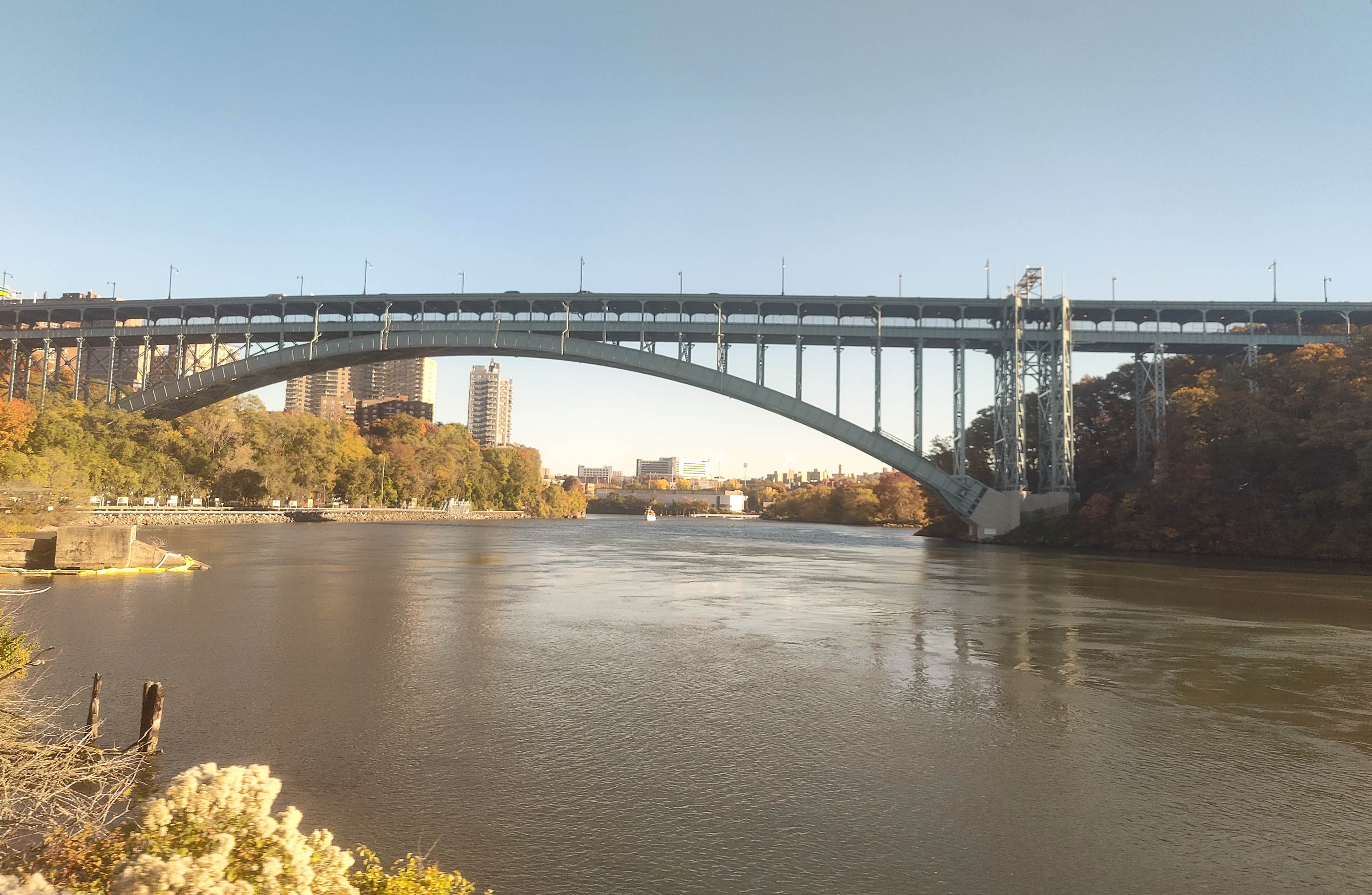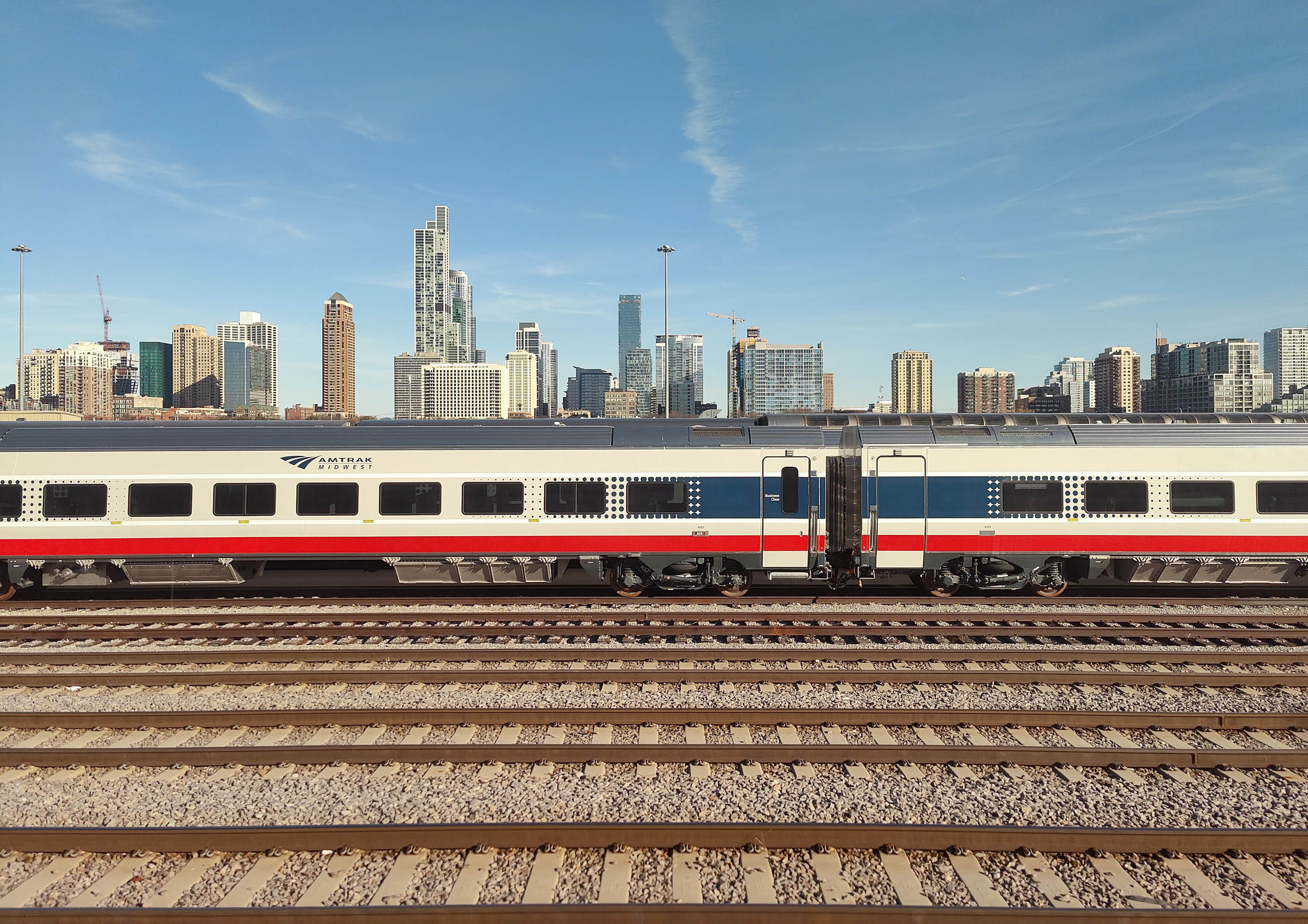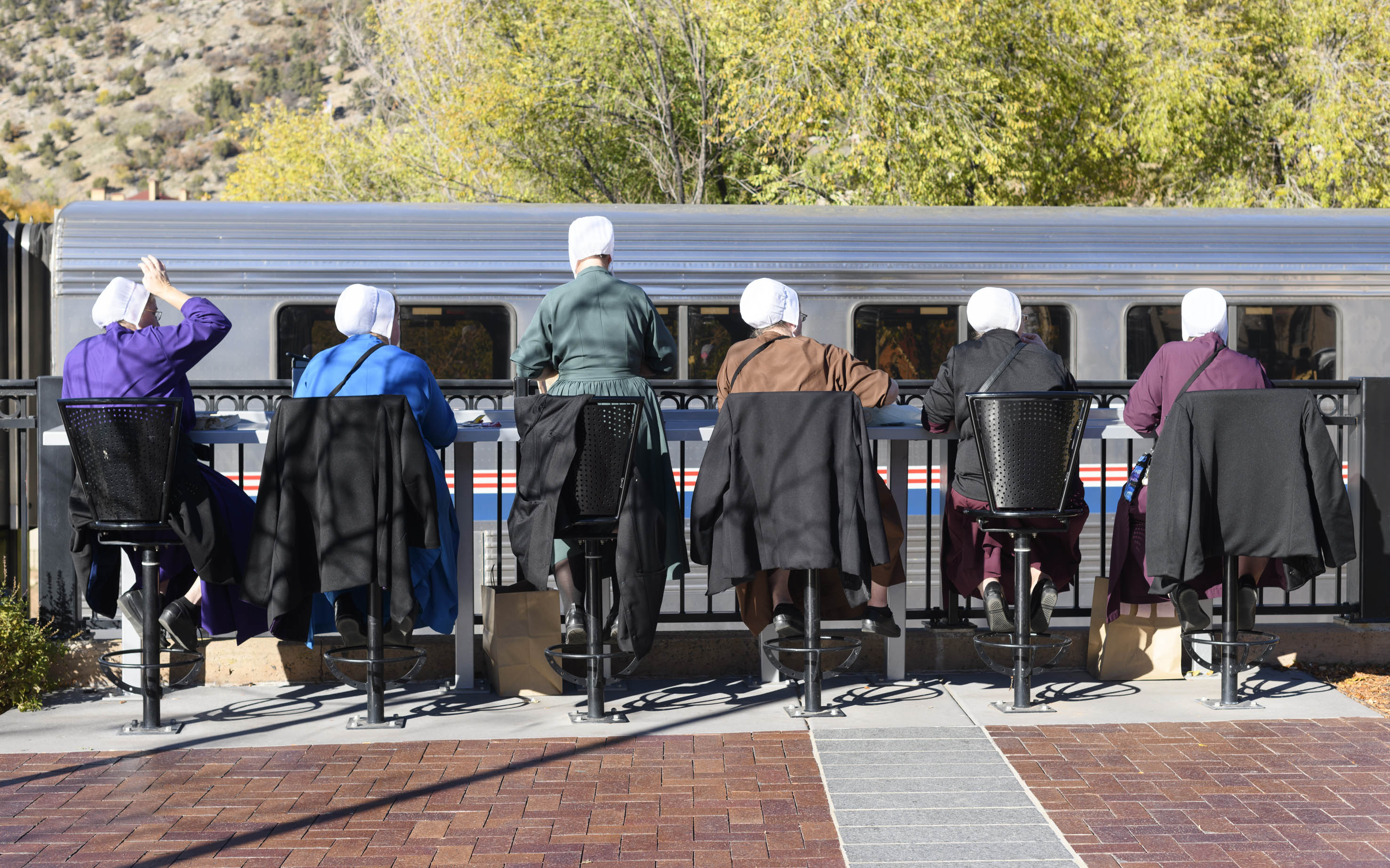

There was a daily race between two steam trains where south Chicago bent around Lake Michigan. The Pennsylvania (PRR) and New York Central (NYC) railroads, 1930s archrivals scheduled their flagship Chicago - Manhattan services to depart at the same time.
Passengers received a red-carpet treatment with three course meals and options for barber and secretarial services. Using only company owned tracks – the NYC’s 20th Century Limited on a flatter ‘water level’ route by Lake Erie and PRR’s Broadway Limited using the ‘Main line’, the competition for speed and comfort challenged the best of the era’s industrial designers and engineers. While not priced for the common person, these experiences captured the public’s imagination of what railway travel could be.
From the 1950s US passenger railways met a sad demise losing to competition from highways and planes. Today there are a handful of long-distance passenger routes helped by large federal subsidies carrying evocative names like ‘The Empire Builder’, ‘Soutwest Chief’ and the ‘Maple Leaf’. In November 2022 I travelled from New York to San Francisco via Chicago with the hope of rediscovering the American rail experience. The former leg - the Lakeshore Limited is scheduled to take 20 hours and run overnight and the latter, the California Zepher is scheduled to take 52 hours. The latter leg is far more famous than the former and I used coach class due to the low availability and relative high cost of sleepers.


In mid-afternoon many trains were already delayed at Penn Station, once the flagship station of the PRR. A small waiting room had the only non-restaurant seats in the busiest station in the US. Passengers boarded the Chicago bound Lakeshore Limited through a dim underground platform. The locomotive hummed and an ‘All onboard’ was called for the overnight service while most passengers slept or stared at their phones.
When completed in 1913, the Beaux-Arts Penn Station featured a Great Hall with a 46m ceiling and a floor area spanning two city blocks. Referred to as ‘a great Doric temple to transportation’, many travellers remarked that everyone no matter their background was made to feel special. While PRR once had a budget second only to the US Government it was near bankrupt in the 1960s. They sold the air-rights for the station which was swiftly demolished to make way for a stadium. Today little remains above ground.
Arch Rival NYC’s station, the Grand Central Terminal nearly met the same fate. Public outcry following the loss of Penn Station helped formally recognise the value of these heritage buildings. Today, even after excluding passengers, it is among the top ten most visited tourist attractions in the world.

In 1971 the ailing passenger railroads were reorganised under one entity which eventually became Amtrak. Track rights were sold to freight companies which rationally prioritised their own trains. As a result, US intercity passenger trains are often late making train travel even less desirable.
The tunnels slowly gave way to a fine late afternoon by the Hudson travelling from Manhattan, Bronx and then upstate. The Lakeshore Limited retraces most of the Water Level Route. A few days earlier I had visited an apple farm and completed a small hike in the same area.







Darkness soon set in. In Albany, a branch train from Boston joins with this train into one set to go to Chicago together. The carriage maintained a steady pace, stopping to drop off passengers at cities like Buffalo, the gateway to Niagara Falls.
The next morning, passengers are greeted by two statues signifying day and night watch over the Grand Hall of Chicago Union station, representing the former around the clock operation. In the context of large stations in the Great Lakes area, Union Station’s continued use is an exception rather than the norm.

Michigan Central Station in Detroit has not served passengers since 1988. The once grand 13 story building was defaced by vandals. Similarly, the 17 story Buffalo Central Terminal ceased serving passengers in 1979 and in its darkest hour the owners sold interior fittings and the building left to ruins. After over 30 years of uncertainty Ford purchased the Michigan central Station for restoration in 2018 hoping to turn it into a new R&D facility. It also reserved 4 tracks should Amtrak one day decide to use the station again. Buffalo Central station is still waiting for a viable plan but in recent years has had some key maintenance work done.
I spent a few days in Chicago exploring its architectural attractions. The suburb of Oak Park was where Frank Lloyd Wright started his architectural career, built his home, and helped drive the distinctly American Prairie school of architecture. This style traded the copying of complex European décor for horizontal lines, simplicity and designs that complement the natural environment. Think eaves which shade the harshest summer heat and let in the lower angled winter sunlight.
Wright found a great mentor in his employer Louis Sullivan who also lent him $5000 to build his own house. However, it went over budget and the ambitious Wright designed ‘bootleg’ houses in his own time to pay the bills. He designed eleven such houses including one built very close to where Sullivan lived. He was promptly fired. Today Prairie style house dot this affluent neighbourhood and Wright’s home is a museum.




Finally, it was time to board the California Zephyr, often considered to be among the world’s most beautiful train rides. Most long-distance routes have daily frequencies and are timed to reserve the best scenery for daytime.


City blocks gave way to fields of corn. The route crossed the flat Prairies of the mid-west in the afternoon light.




The train set consisted of two locomotives pulling a collection of double story cars called Superliners. These included a baggage car, sleeper cars, a dining car, an observation car with seat to ceiling windows and finally coach cars.
In the observation cars many people read and some played cards. A large Amish group is travelling by Amtrak from Cincinnati to San Diego. At night four of them played a dice game on a communal table while others in the group wrote. They leaned towards the centre of the table and every now and then a jovial fit of laughter erupted into the long car.
I asked an elderly Amish lady about how the game worked.
‘It is a stupid game.’
‘They have two dice and one pen in the middle of the table. When two dice show the same number they rush to get the pen. The first to get it adds the number on the dice to their tally. The first to add to or past 100 wins.’ An elderly man in the group smiled and shook his head.
Overnight the train left the prairies for the foothill of the continental divide. The longest break of the trip happens in Denver with a stop of around an hour. Passengers have a chance to explore the surrounds of the station while the train refuelled and had its windows cleaned. Annoyingly the windows looked worse after cleaning.


The mountains to the west rise to over 4000 metres. The quest to connect Denver with the West Coast attracted the interest of Colorado industrialist David Moffat in the early 1900s and eventually consumed his entire fortune. The original track crossing over mountains had sections with 4% gradient, a substantial challenge for trains of the era. The route also required extensive snow removal. There was an ambitious vision to build a ten-kilometre tunnel bypassing the divide and reducing the distance to the west coast by 283km. Moffat would not see the results of this tunnel when he died in 1911. When finally completed in 1928, the single lane tunnel was named in his honour and today stands as the only surviving westward railroad connection from Denver.
Crossing the tunnel allowed trains to access the the upper reaches of the Colorado river and follow its banks downstream. The track first traversed steep canyons before the Colorado river broadened out. Many holiday makers stop at Glenwood Springs for a few days to enjoy the hot springs and take in fresh mountain air. Groves of poplars turn bright yellow against a backdrop of snow-covered peaks. As the sun set on the second day, we depart the banks of the Colorado River for the last time after passing through Ruby Canyon.





At dawn on day three passengers were greeted by the snowy high plains of Nevada. The final mountain pass before reaching coastal California is the infamous Donner Pass. In 1846 a group of 81 California bound settlers were delayed after taking an alternative route and and then stranded by heavy snow. They were forced to spend the winter here. With dwindling supplies and plummeting temperatures, some turned to cannibalism and only 46 survived.




The train route follows one like that used by the Donner Party following the Truckee River upstream. A significant amount of snow had fallen over the past few days. With only a short delay to clear snow the Zephyr ploughed on. It is amazing how smooth the train ran. Late on an earlier night a conductor elaborated on track quality as I struggled to read due to a bumpy ride.
‘We are on BNSF (Burlington Norfolk Santa Fe) tracks. These tracks take heavy loads of coal and are not maintained well.’
‘UP (Union Pacific) tracks tend to be far better maintained and you can often feel the difference’
We chatted to 11pm in the observation car. He put his conductor’s cap on the table and occasionally scribbled away, noting the reasons for every little delay.
‘If you are interested in the Zephyr there is a good Facebook group of interested passengers and employees’
I asked to join and saw a devout community of rail enthusiasts. Some even venture to vantage points to photograph the Zephyr passing at scenic locations.
Despite Amtrak’s clear pride for the Zephyr service it was clear financial constraints still limited the quality of the service. At the time of writing the coach class customers could only buy food from the café under the observation car and were not allowed in the more upmarket restaurant. It was widely acknowledged that the café food quality as ‘hit and miss’ while the restaurant food being of a much better quality. Prior to 2019 there was even a full onboard kitchen but this has been reduced to heating pre-cooked meals to save costs. When it was snowing near the Donner Pass, I felt a desire to try the restaurant experience at extra cost but due to Amtrak’s current management they cannot accommodate coach customers. Despite investing in great observing cars, many passengers suggested that they could have done a better job of cleaning the windows than then Denver crew. Using paper towel to wipe the inside also revealed significant amounts of grease and grime. This impacts the viewing experience with glare makes taking good photos difficult.
As we approached the Pacific snow reduced to a misty rain. Mountains dropped to lowlands.

Unlike the steam trains there was no race. The Zephyr arrived five minutes ahead of schedule after 51.5 hours thanks to skilful operation. There were also few luxuries, especially in coach class yet the scenery and conversations brought in many smiles. Journeys like this show a fantastic diversity of landscapes from the comfort of a train and touch on stories of those who dreamed of overcoming adversity. As the coach pulls to a final stop at the unmanned Emeryville station, one wonders what Moffat thinks of this lone passenger train among freight giants carrying a new generation of travellers through the prairies, mountains and canyonlands using the route he envisioned.